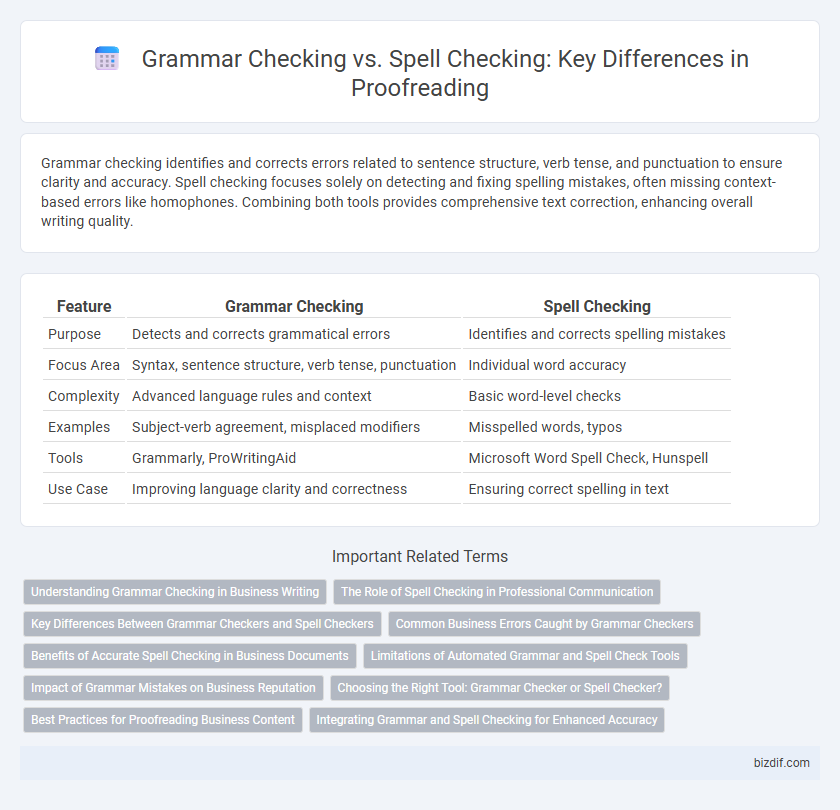Grammar checking identifies and corrects errors related to sentence structure, verb tense, and punctuation to ensure clarity and accuracy. Spell checking focuses solely on detecting and fixing spelling mistakes, often missing context-based errors like homophones. Combining both tools provides comprehensive text correction, enhancing overall writing quality.
Table of Comparison
| Feature | Grammar Checking | Spell Checking |
|---|---|---|
| Purpose | Detects and corrects grammatical errors | Identifies and corrects spelling mistakes |
| Focus Area | Syntax, sentence structure, verb tense, punctuation | Individual word accuracy |
| Complexity | Advanced language rules and context | Basic word-level checks |
| Examples | Subject-verb agreement, misplaced modifiers | Misspelled words, typos |
| Tools | Grammarly, ProWritingAid | Microsoft Word Spell Check, Hunspell |
| Use Case | Improving language clarity and correctness | Ensuring correct spelling in text |
Understanding Grammar Checking in Business Writing
Grammar checking in business writing ensures clarity, professionalism, and accuracy by identifying errors in sentence structure, verb tense, and subject-verb agreement. Unlike spell checking, which only detects misspelled words, grammar checking evaluates context and syntax to improve overall message effectiveness. Utilizing advanced grammar checking tools reduces misunderstandings and enhances communication with clients, stakeholders, and colleagues.
The Role of Spell Checking in Professional Communication
Spell checking plays a critical role in maintaining professionalism by identifying and correcting typographical errors that can undermine the credibility of business documents. Unlike grammar checking, which focuses on syntax, punctuation, and sentence structure, spell checking ensures accurate word usage and prevents commonly confused homophones from distracting the reader. Effective spell checking enhances clarity, fosters trust, and supports the overall quality of professional communication across emails, reports, and presentations.
Key Differences Between Grammar Checkers and Spell Checkers
Grammar checkers analyze sentence structure, syntax, and the correct use of parts of speech to ensure clarity and coherence, while spell checkers primarily identify and correct misspelled words based on dictionary matching. Grammar checkers can detect errors like subject-verb agreement, improper tense usage, and misplaced modifiers, whereas spell checkers cannot catch contextual or grammatical mistakes. Integrating both tools enhances writing accuracy by addressing distinct language aspects that contribute to overall text quality.
Common Business Errors Caught by Grammar Checkers
Grammar checkers identify common business errors such as subject-verb agreement, incorrect tense usage, and misplaced modifiers that spell checkers often miss. They also detect issues with punctuation, sentence structure, and word choice that impact the clarity and professionalism of business communications. Effective grammar checking improves readability and reduces misunderstandings in emails, reports, and presentations.
Benefits of Accurate Spell Checking in Business Documents
Accurate spell checking in business documents ensures professionalism by eliminating typographical errors that can undermine credibility and client trust. It enhances readability and comprehension, reducing the risk of miscommunication and costly misunderstandings. Reliable spell checking tools save time and increase efficiency, allowing businesses to maintain high-quality, error-free content across all communications.
Limitations of Automated Grammar and Spell Check Tools
Automated grammar and spell check tools often fail to capture nuanced language errors, such as context-specific word usage and complex sentence structures. These tools struggle with homophones, idiomatic expressions, and subtle grammatical mistakes, leading to inaccurate corrections or overlooked errors. Relying solely on automated checks can result in overlooked issues that require human proofreading for precise and thorough editing.
Impact of Grammar Mistakes on Business Reputation
Grammar mistakes can significantly damage a business reputation by undermining professionalism and credibility in written communication. Unlike spell checking, which only identifies typographical errors, grammar checking detects structural issues that affect the clarity and tone of messages. Accurate grammar ensures clear messaging, fostering trust and positively influencing customer perceptions and brand image.
Choosing the Right Tool: Grammar Checker or Spell Checker?
Selecting the right tool depends on the specific needs of your text; grammar checkers analyze sentence structure, punctuation, and syntax for overall clarity, while spell checkers focus solely on identifying and correcting misspelled words. Advanced grammar checking tools, such as Grammarly and ProWritingAid, offer comprehensive feedback including context-aware corrections and style suggestions, whereas basic spell checkers integrated into word processors provide quick fixes for typographical errors. For professional writing or academic work, investing in a robust grammar checker ensures polished, error-free content beyond simple spelling accuracy.
Best Practices for Proofreading Business Content
Effective proofreading of business content involves prioritizing grammar checking over spell checking to ensure clarity and professionalism. Grammar checking identifies errors in sentence structure, verb tense consistency, and punctuation, which are crucial for conveying the intended message accurately. Spell checking alone addresses typos but cannot detect contextual mistakes, making comprehensive grammar review essential for polished and credible business communication.
Integrating Grammar and Spell Checking for Enhanced Accuracy
Integrating grammar and spell checking tools significantly enhances overall text accuracy by identifying both syntactical errors and typos that standalone checkers might overlook. Advanced algorithms analyze context, ensuring that homophones and commonly confused words are correctly used, while also maintaining proper sentence structure. This combined approach reduces errors more effectively than separate applications, streamlining the proofreading process for clearer, more polished writing.
Grammar Checking vs Spell Checking Infographic

 bizdif.com
bizdif.com